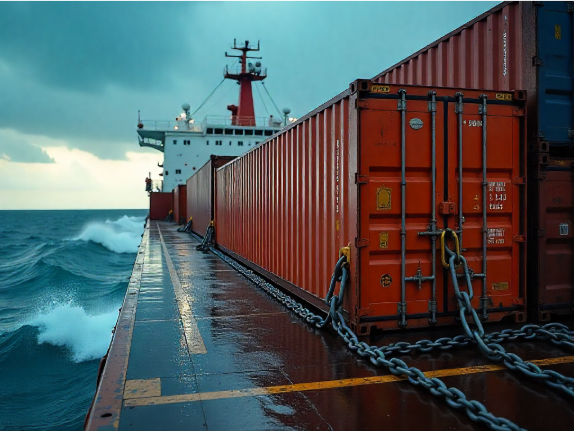Proper cargo stowage and securing is vital for maritime safety, protecting both valuable goods and vessels during transport. Cargo that shifts or falls at sea can cause serious damage, injuries, and financial losses. With many maritime incidents traced back to poor securing practices, understanding these methods is essential for anyone involved in shipping operations.
Cargo securing systems include a range of techniques and equipment designed to keep loads stable. These methods fall into two main categories: friction-fitted securing, which relies on clamping and frictional forces, and form-fitted securing, which blocks movement physically. Depending on the type of cargo, strapping options like diagonal or oblique lashing may be required. To optimize loading a shipping container, tools such as container load planning software or a container loading calculator can help maximize space and ensure proper weight distribution.
Beyond safety, effective securing also supports cost-efficiency and regulatory compliance. Strict international and local rules govern how cargo must be stowed and secured, and following them helps businesses avoid fines, delays, and liability. From blocked cargo against ship structures to calculating requirements for expected accelerations at sea, mastering these principles is key to safe, efficient, and profitable maritime transport.
Contents
What is Cargo Stowage and Why It Matters
Cargo stowage is the strategic art of positioning goods within a vessel to prevent movement during transit. Unlike casual loading, this precise process involves careful planning, proper weight distribution, and secure fastening to safeguard against the unpredictable nature of sea voyages.
Stowage Plays a Critical Role in Three Essential Areas
- Crew safety – proper stowage prevents shifting cargo that could crush personnel, block escape routes, or create hazardous working conditions during the voyage.
- Vessel structural integrity – secure stowage avoids excessive forces on the ship’s structure, which could exceed design limits and result in permanent damage or dangerous failures.
- Cargo protection – correct stowage ensures goods arrive undamaged, reducing financial losses and safeguarding commercial relationships.
Notably, every vessel handling non-bulk cargo must carry an approved Cargo Securing Manual containing specific information about securing equipment, procedures, and limitations. Container load planning software helps optimize both space utilization and safety parameters, making proper stowage both safer and more efficient.
Fact: Load securing is essential not only on the ocean but on the roads as well. According to Forbes, between 2011-2014, improperly secured loads contributed to over 200,000 crashes, 39,000 injuries, and 500 deaths.
Main Cargo Securing Methods Explained
| Description | Best for | Key Materials/ Tools | Benefits | Method |
| Ropes, straps, chains, or wires used to tie down cargo with proper tension. | Heavy and oddly-shaped loads; chain lashings effective up to 5,000 kg (11,000 lbs). | Ropes, straps, chains, wires | High strength, versatile, keeps cargo tightly secured. | Lashing |
| Physical barriers around cargo to restrict movement and transfer forces. | Preventing cargo shift in all directions. | Wooden blocks, metal beams | Strong stability, minimal deformation, protects vessel structure. | Blocking & Bracing |
| Materials placed between cargo items to prevent movement and damage. | Fragile or sensitive items; filling empty spaces. | Wood, inflatable airbags, plastic, foam | Prevents friction damage, absorbs shocks, stabilizes loads. | Dunnage |
| Loops directly across cargo to secure it to loads. | Regularly shaped cargo, equipment, or machinery. | Straps (metal or synthetic) | Simple, cost-effective, keeps cargo fixed in place. | Strapping |
| Netting with multiple attachment points securing irregular cargo. | Oddly shaped or mixed-dimension cargo. | Polyester, polypropylene, Kevlar webbing | Flexible, adaptable to different shapes and sizes. | Cargo Nets |
| Covers protecting cargo from environmental exposure. | Weather-sensitive cargo, construction materials, outdoor storage. | Waterproof tarps, UV-resistant tarps | Shields from rain, wind, snow, and UV; maintains structural integrity. | Tarping |
Best Practices for Safe and Efficient Cargo Securing
Cargo stowage and securing are the foundation of safe maritime operations, with the International Maritime Organization (IMO) stressing their role in preventing casualties, injuries, and loss of life. A solid securing plan should outline methods, tools, and responsibilities, supported by regular inspections and maintenance of equipment. Weight distribution is equally critical—cargo must be stable, with its center of gravity kept low and balanced. Understanding cargo characteristics is key, as heavy machinery requires strong lashing, while fragile goods need careful bracing and protective dunnage.
Beyond planning and equipment, trained personnel make the difference. The CTU Code offers clear guidance for safe packing and securing, ensuring staff work efficiently and minimize risks. Modern technology such as container load planning software further enhances safety and profitability by optimizing cargo placement, maximizing space, and improving utilization. Together, these practices reduce losses, ensure compliance, and strengthen customer confidence.
Conclusion
Proper cargo stowage and securing are not just best practices—they are vital for maritime safety, protecting crews, vessels, and valuable goods. Strategic cargo positioning prevents dangerous shifting at sea, while techniques like lashing, blocking, bracing, and dunnage ensure that different cargo types are transported safely and efficiently. By applying the right securing method for each shipment, companies preserve vessel integrity, reduce accidents, and guarantee undamaged delivery.
Beyond safety, effective securing brings clear financial and operational benefits. Fewer damage claims, minimized liability, and reduced delays all translate into measurable cost savings. With regulations requiring a Cargo Securing Manual and regular inspections, compliance is non-negotiable. Ultimately, mastering cargo stowage and securing practices—supported by staff training and modern planning tools—strengthens efficiency, ensures smoother voyages, and contributes to safer, more reliable global trade.
Sources:
- https://www.easycargo3d.com/en/try-container-loading-calculator-online-for-free/
- https://www.forbes.com/sites/tanyamohn/2016/08/11/road-debris-can-kill-you-new-report-reveals-growing-danger/
- https://www.seably.com/courses/cargo-securing-training/lessons/2/steps/1
- https://www.safetex.de/en/products/industry-program/cargo-securing-methods/







